Southeast Asia Bioplastics Market Size
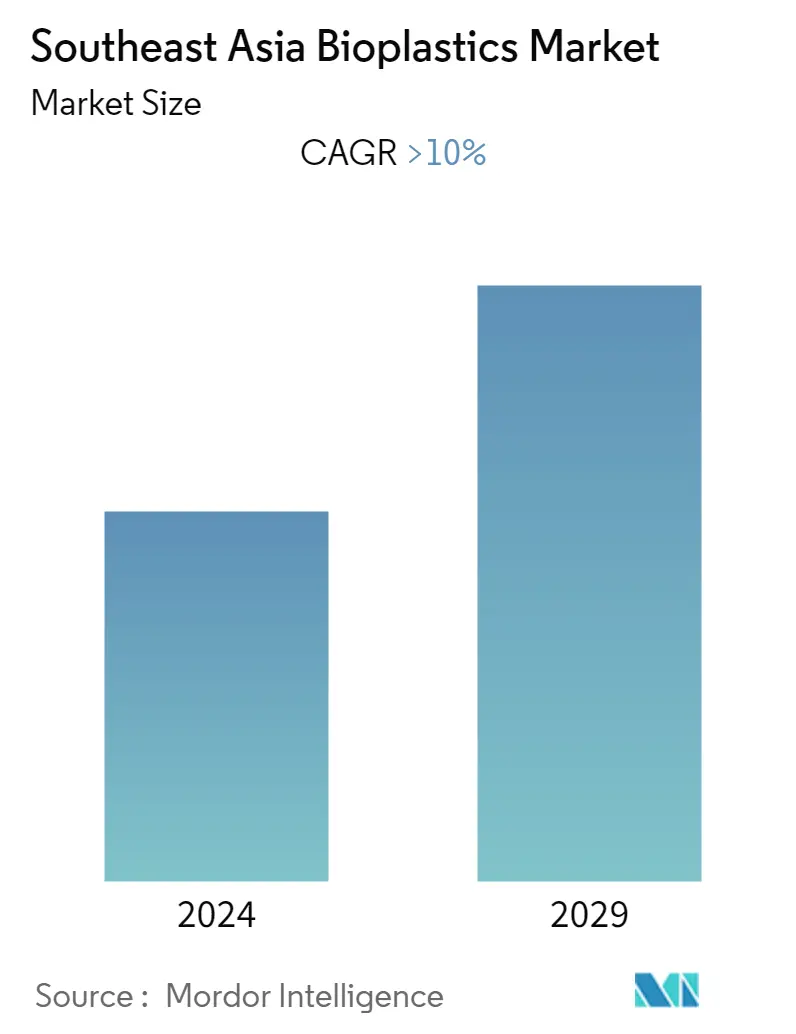
| Study Period | 2019 - 2029 |
| Base Year For Estimation | 2023 |
| Forecast Data Period | 2024 - 2029 |
| Historical Data Period | 2019 - 2022 |
| CAGR | > 10.00 % |
| Market Concentration | High |
Major Players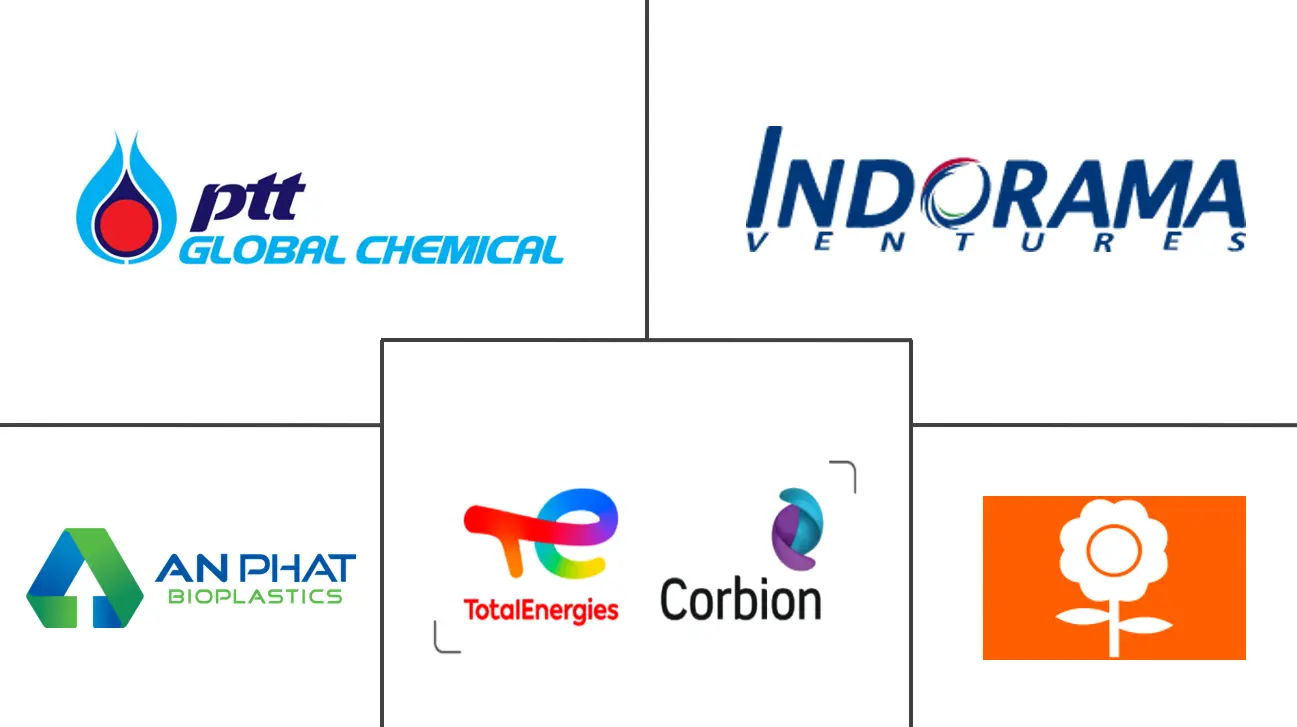
*Disclaimer: Major Players sorted in no particular order |
Southeast Asia Bioplastics Market Analysis
The Southeast Asia bioplastics market is expected to register a CAGR of over 10% during the forecast period.
COVID-19 negatively impacted the production and supply of bioplastics during the lockdown. However, the demand from the packaging segment surged due to the increasing use of online food and e-commerce service during the pandemic. After 2020, the market improved steadily due to the continuous activities in the Southeast Asian region.
- Growing demand for bioplastics in packaging and environmental factors encouraging a paradigm shift is expected to drive the bioplastics market's growth in Southeast Asia.
- However, the availability of cheaper alternatives is the primary factor hindering the market's growth.
- Growing use in the electronics industry will likely be an opportunity.
- Indonesia is expected to dominate the bioplastics market in Southeast Asia and is also likely to witness the highest CAGR during the forecast period.
Southeast Asia Bioplastics Market Trends
This section covers the major market trends shaping the Southeast Asia Bioplastics Market according to our research experts:
Rising Demand for bioplastics for the Flexible Packaging
- The primary utilization of bioplastics is in the flexible packaging segment because they are not harmful to nature, and few are easily degradable as well. Furthermore, countries like Singapore, Indonesia, Thailand, Malaysia, and the Philippines are driving the domestic demand for bioplastics to new heights in the flexible packaging sector.
- The utilization of bioplastics is increasing in the packaging world due to environmental concerns across the Southeast Asian region and are used for the packaging of food items, medicines, beverage bottles, packaging films, and packaging of non-food products, such as napkins and tissues, toilet paper, nappies, and sanitary towels.
- Bioplastics are increasingly being utilized to make plastic bags, as they are nature-friendly and organic waste collection bags commonly used in hospitals, hotels and restaurants, industrial and retail establishments, and homes.
- Bioplastics are widely used in the e-commerce industry to package FMCG products, medications, electronics, food, etc. According to the Malaysian Communications and Multimedia Commission, the e-commerce business rose by 10.7% in 2021 over the previous year, supporting the investigated market. Furthermore, by the end of 2021, e-commerce will have contributed USD 45.66 billion to Malaysia's GDP.
- In April 2022, the Thailand government announced that the cabinet has agreed on an extension of a 25% tax exemption for corporate bioplastics business to promote Thailand as an ASEAN bioplastics hub.
- Therefore, considering the abovementioned factors, the demand for the bioplastics market is expected to rise significantly in the flexible packaging segment shortly.
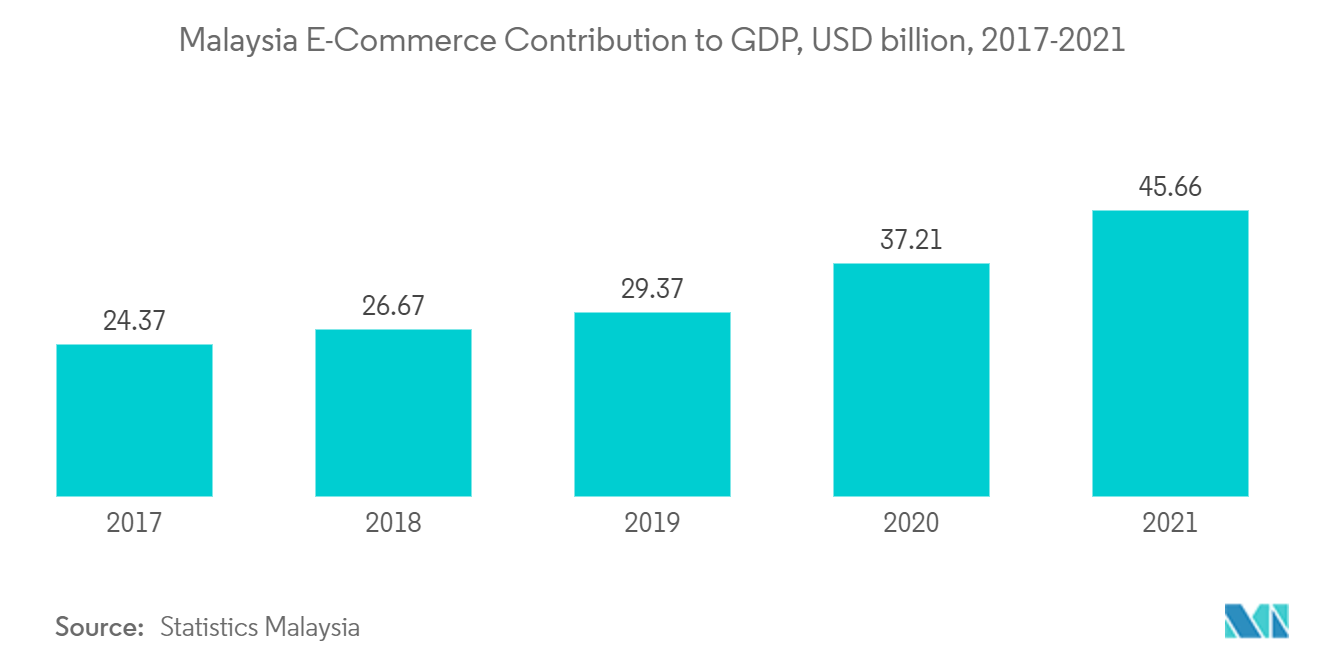
Indonesia is Expected to Hold Significant Market Share
- Indonesia is expected to dominate the market for bioplastics in Southeast Asia during the forecast period, owing to the demand from major end-user industries such as packaging, agriculture, construction, automotive, and others.
- The palm oil industry in Indonesia is a significant contributor to the country's economy. Researchers at Universiti Sains Malaysia have developed a new bioplastic film made from a byproduct of palm oil. In Malaysia, 19.8 million tonnes of waste palm oil fruit bunches are thrown each year; the researchers converted hemicellulose from waste palm oil fruit bunches into biodegradable films for green packaging. According to the United States Department of Agriculture, the harvestable land area for palm oil in Indonesia will reach 12.5 million hectares by 2022.
- Bioplastics have increasingly been used in agriculture applications such as agricultural mulches, seeding strips, and tapes. According to Asian Development Bank, value added in agriculture in Indonesia was around 1.8% in 2021, about the same as in 2020. Its value was around 3.6% in 2019, which decreased due to the COVID-19 crisis.
- According to the Organisation Internationale des Constructeurs d'Automobiles (OICA), Indonesia produced around 1.12 million units of vehicles in 2021, witnessing a growth rate of 63%, compared to the previous year. Bio-based PA, PTT, PLA, PHA, and PBS are some of the most often used bioplastics in the automobile industry, demonstrating the growing use of bioplastics in the automotive sector.
- The electronics industry in Indonesia largely serves the local industry, with very little export. However, mobile phone production has hugely benefitted from the high growth of smartphone users in the country. This is expected to boost the demand for bioplastics in the country.
- (Polylactic Acid) PLA is used as sealants, and insulants, replacing petrochemical plastics in the construction industry. According to Statistics Indonesia, Indonesia has 203.4 thousand construction establishments in 2021, an increase from 159 thousand construction establishments in 2020.
- All aforementioned factors are likely to fuel the growth of the bioplastics market in Southeast Asia over the forecast period.
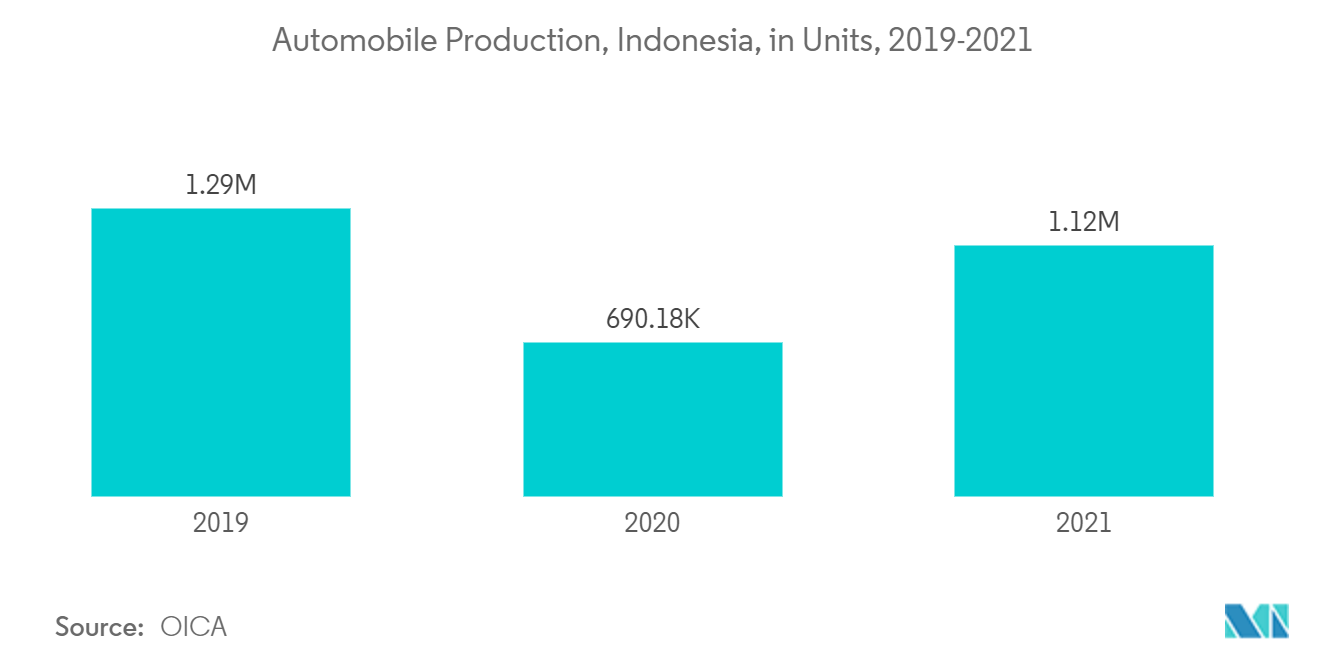
Southeast Asia Bioplastics Industry Overview
Southeast Asia's bioplastics market is consolidated in nature. Some of the major players in the market (not in any particular order) include TotalEnergies Corbion, PTT MCC Biochem Co., Ltd., Indorama Ventures Public Company Limited, AN PHÁT BIOPLASTICS, THANTAWAN INDUSTRY PLC, among others.
Southeast Asia Bioplastics Market Leaders
-
TotalEnergies Corbion
-
PTT MCC Biochem Co., Ltd.
-
Indorama Ventures Public Company Limited
-
AN PHÁT BIOPLASTICS
-
THANTAWAN INDUSTRY PLC
*Disclaimer: Major Players sorted in no particular order
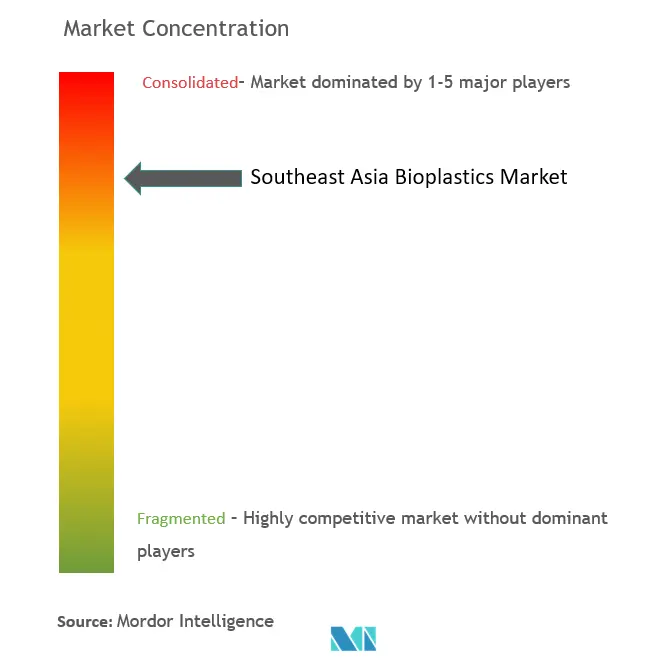
Southeast Asia Bioplastics Market News
- In May 2022, CJ Bio, a South Korea-based CJ CheilJedang, started manufacturing PHA polyester at a newly commissioned facility capacity of 5,000 tonnes in Pasuruan, Indonesia. This material will be used as a modifier of biopolymers to improve their biodegradability.
- In January 2022, NatureWork's announced a new facility for biopolymer manufacturing. This will be located in Nakhon Sawan Bio complex, Thailand, with 75'000 tons per year of Ingeo polylactic acid (PLA) annually, which is used in applications like compostable food packaging.
Southeast Asia Bioplastics Market Report - Table of Contents
1. INTRODUCTION
1.1 Study Assumptions and Market Definition
1.2 Scope of the Study
2. RESEARCH METHODOLOGY
3. EXECUTIVE SUMMARY
4. MARKET DYNAMICS
4.1 Drivers
4.1.1 Growing Demand for Bioplastics in Packaging
4.1.2 Environmental Factors Encouraging a Paradigm Shift
4.2 Restraints
4.2.1 Availability of Cheaper Alternatives
4.2.2 Other Restraints
4.3 Industry Value Chain Analysis
4.4 Porter's Five Forces Analysis
4.4.1 Bargaining Power of Suppliers
4.4.2 Bargaining Power of Consumers
4.4.3 Threat of New Entrants
4.4.4 Threat of Substitute Products and Services
4.4.5 Degree of Competition
5. MARKET SEGMENTATION (Market Size in Volume)
5.1 Type
5.1.1 Bio-based Biodegradables
5.1.1.1 Starch-based
5.1.1.2 Polylactic Acid (PLA)
5.1.1.3 Polyhydroxy Alkanoates (PHA)
5.1.1.4 Polyesters (PBS, PBAT and PCL)
5.1.1.5 Other Bio-based Biodegradables
5.1.2 Bio-based Non-biodegradables
5.1.2.1 Bio Polyethylene Terephthalate (PET)
5.1.2.2 Bio Polyethylene
5.1.2.3 Bio Polyamides
5.1.2.4 Bio Polytrimethylene Terephthalate
5.1.2.5 Other Non-biodegradables
5.2 Application
5.2.1 Flexible Packaging
5.2.2 Rigid Packaging
5.2.3 Automotive and Assembly Operations
5.2.4 Agriculture and Horticulture
5.2.5 Construction
5.2.6 Textiles
5.2.7 Electrical and Electronics
5.2.8 Other Applications
5.3 Geography
5.3.1 Indonesia
5.3.2 Malaysia
5.3.3 Philippines
5.3.4 Singapore
5.3.5 Thailand
5.3.6 Rest of Southeast Asia
6. COMPETITIVE LANDSCAPE
6.1 Mergers and Acquisitions, Joint Ventures, Collaborations, and Agreements
6.2 Market Share (%)**/Ranking Analysis
6.3 Strategies Adopted by Leading Players
6.4 Company Profiles
6.4.1 AN PHAT BIOPLASTICS
6.4.2 D&L Polymers & Colours, Inc.
6.4.3 Indorama Ventures Public Company Limited
6.4.4 Prepack Thailand Co., Ltd.
6.4.5 PTT MCC Biochem Co., Ltd.
6.4.6 REANGWA
6.4.7 THANTAWAN INDUSTRY PLC
6.4.8 TotalEnergies Corbion
- *List Not Exhaustive
7. MARKET OPPORTUNITIES AND FUTURE TRENDS
7.1 Growing Use in the Electronics Industry
Southeast Asia Bioplastics Industry Segmentation
Bioplastics are a type of plastic produced from natural resources such as sugar cane, sugar beet, corn starch, potato starch, vegetable fats and oils, wood pulp, wheat straw, and other natural resources. To get the final product, these natural resources follow numerous processes, such as hydrolysis and fermentation, dehydration/esterification/compounding, and polymerization.
The Southeast Asia bioplastics market is segmented by type, application, and geography. By type, the market is segmented into bio-based biodegradables (starch-based, polylactic acid (PLA), polyhydroxyalkanoates (PHA), polyesters (PBS, PBAT, and PCL), and other bio-based biodegradables) and bio-based non-biodegradables (bio polyethene terephthalate (PET), bio polyethene, bio polyamides, bio poly trimethylene terephthalate, and other non-biodegradables). By application, the market is segmented into flexible packaging, rigid packaging, automotive and assembly operations, agriculture and horticulture, construction, textiles, electrical and electronics, and other applications. The report also covers the market size and forecasts for the bioplastics market in 5 major countries across the Southeast Asia region. For each segment, the market sizing and forecasts have been done based on volume (kilotons).
| Type | |||||||
| |||||||
|
| Application | |
| Flexible Packaging | |
| Rigid Packaging | |
| Automotive and Assembly Operations | |
| Agriculture and Horticulture | |
| Construction | |
| Textiles | |
| Electrical and Electronics | |
| Other Applications |
| Geography | |
| Indonesia | |
| Malaysia | |
| Philippines | |
| Singapore | |
| Thailand | |
| Rest of Southeast Asia |
Southeast Asia Bioplastics Market Research FAQs
What is the current Southeast Asia Bioplastics Market size?
The Southeast Asia Bioplastics Market is projected to register a CAGR of greater than 10% during the forecast period (2024-2029)
Who are the key players in Southeast Asia Bioplastics Market?
TotalEnergies Corbion , PTT MCC Biochem Co., Ltd. , Indorama Ventures Public Company Limited , AN PHÁT BIOPLASTICS and THANTAWAN INDUSTRY PLC are the major companies operating in the Southeast Asia Bioplastics Market.
What years does this Southeast Asia Bioplastics Market cover?
The report covers the Southeast Asia Bioplastics Market historical market size for years: 2019, 2020, 2021, 2022 and 2023. The report also forecasts the Southeast Asia Bioplastics Market size for years: 2024, 2025, 2026, 2027, 2028 and 2029.
Southeast Asia Bioplastics Industry Report
Statistics for the 2024 Southeast Asia bioplastics market market share, size and revenue growth rate, created by Mordor Intelligence™ Industry Reports. Southeast Asia bioplastics market analysis includes a market forecast outlook to 2029 and historical overview. Get a sample of this industry analysis as a free report PDF download.



